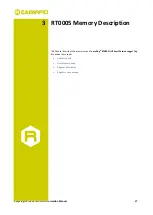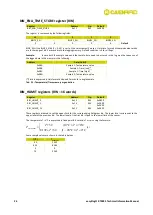
easy2log© RT0005 Technical Information Manual
16
Mean Kinetic Temperature calculation
The Mean Kinetic Temperature (MKT) is a simplified way of expressing the overall effect of temperature fluctuations
during storage or transit of perishable goods. MKT is useful in order to monitor the status of perishable items during a
shipment. The RT0005 tag is able to update the MKT every time it samples a new temperature. The MKT function can
be enabled or disabled toggling the state of the MKTE flag in the CONTROL register.
MKT is calculated using the following formula:
n
e
e
e
R
H
MKT
n
RT
H
RT
H
RT
H
...
ln
2
1
(1)
where ΔH is the MKT activation energy constant expressed in J/mol, R is the universal gas constant, n is the number of
samples and Tn is the temperature of the different samples expressed in °K.
The user can set a threshold value for the MKT; if the MKT exceeds the threshold, the tag generates an alarm setting to
1 the MKT_ALARM bit in the STATUS register.
The current MKT value can be obtained reading the MKT_VAL register while the threshold can be set writing the
desired value in the MKT_THRESHOLD register.
Remaining Shelf Life calculation
Shelf Life is the length of time that perishable items are given before they are considered unsuitable for sale or
consumption. For many products the spoilage rate increase of a perishable good is an exponential function of
temperature.
As well as the Mean Kinetic Temperature, the remaining Shelf Life calculation is useful in order to monitor the status of
an item during the shipment. The RT0005 tag is able to calculate the remaining Shelf Life using a linear approximation
of the Arrhenius algorithm every time it samples a new temperature. The remaining Shelf Life calculation can be
enabled or disabled toggling the state of the ARRE flag in the CONTROL register.
The remaining Shelf Life is expressed in hours and is calculated with the following formula:
n
n
T
T
ref
n
t
Q
SHL
SHL
ref
n
10
10
(2)
where SHL
ref
is the Shelf Life reference expressed in hours, Tn is the temperature of the different samples expressed in
°C, T
ref
is the reference temperature expressed in °C, Q10 (unit less number) is defined as the ratio of the reaction rate
constants at temperatures differing by 10 °C from the reference temperature and t
n
is the sampling interval expressed
in hours for the selected bin.
The user can set a threshold value for the remaining Shelf Life; if the remaining Shelf Life is lower than the threshold,
the tag generates an alarm setting to 1 the SHL_ALARM bit in the STATUS register.The remaining Shelf Life value can be
obtained reading the SHL_TIME register while the threshold can be set writing the desired value in the
SHL_THRESHOLD register.
The remaining Shelf Life value can be obtained reading the SHL_TIME register while the threshold can be set writing
the desired value in the SHL_THRESHOLD register.
Battery measurement and behaviour
The RT0005 tag includes a battery measurement circuitry that allows to control the battery charge level.
Four battery charge levels are defined: Full (3), Normal (2), Low (1), Empty (0); values can be obtained reading the
BAT_LSBIT and BAT_MSBIT in the STATUS register. The RT0005 tag behave normally when the battery is at the Full or
Normal battery level, while it is automatically put in Sleep state when the level reach the Low value.
When the battery level status is Low (1) or Empty (0) the battery level is considered critical so the condition is reported
by the manual interface as described in the relevant paragraph.
















































